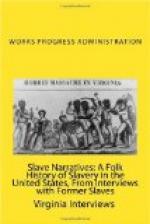Although there was only one distribution of clothing per year nobody suffered from the lack of clothes because this one lot had enough to last a year if properly cared for. The children wore one piece garments, a cross between a dress and a slightly lengthened shirt, made of homespun or crocus material [TR note: “crocus” is a coarse, loosely woven material like burlap]. No shoes were given them until winter and then they got the cast-offs of the grown ups. The men all wore pants made of material known as “ausenberg”. The shirts and under wear were made of another cotton material. Dresses for the women were of striped homespun. All shoes were made on the premises of the heaviest leather, clumsely fashioned and Uncle Mose says that slaves like his father who worked in the mansion, were given much better clothing. His father received of “The Colonel” and his grown sons many discarded clothes. One of the greatest thrills of Mose’s boyhood was receiving first pair of “ausenberg” pants. As his mother had already taught him to knit (by using four needles at one time) all that he had to do was to go to his hiding place and get the socks that he had made.
None of the clothing worn by the slaves on this particular plantation was bought. Everything was made by the slaves, even to the dye that was used.
Asked if there was sufficient food for all slaves, Uncle Mose said “I never heard any complaints.” At the end of each week every family was given some fat meat, black molasses, meal and flour in quantity varying with the size of the family. At certain intervals during the week, they were given vegetables. Here too, as in everything else, Mose’s father was more fortunate than the others, since he took all his meals at the mansion where he ate the same food served to the master and his family. The only difference between Week-day and Sunday diet was that biscuits were served on Sundays. The children were given only one biscuit each. In addition to the other bread was considered a delicacy. All food stuff was grown on the plantation.
The slave quarters were located a short distance below the mansion. The cabins one-roomed weatherboard structures were arranged so as to form a semi-circle. There was a wide tree-lined road leading from the master’s home to these cabins.
Furnishings of each cabin consisted of one or two benches, a bed, and a few cooking utensils. These were very crude, especially the beds. Some of them had four posts while the ends of others were nailed to the walls. All lumber used in their construction was very heavy and rough. Bed springs were unheard of—wooden slats being used for this purpose. The mattresses were large ausenberg bags stuffed to capacity with hay, straw, or leaves. Uncle Mose told about one of the slaves, named Ike, whose entire family slept on bare pine straw. His children were among the fattest on the plantation and when Colonel Davis tried to make him put this straw in a bag he refused claiming that the pine needles kept his children healthy.




